Lactate Myth Buster
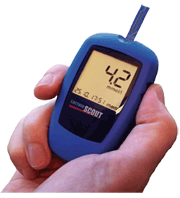 If
ever there was a black art, smoke and mirrors, myth and legend side to
the voodoo and wizardry of cycling, then the world of lactate is surely it.
If
ever there was a black art, smoke and mirrors, myth and legend side to
the voodoo and wizardry of cycling, then the world of lactate is surely it.
Lactate physiology, by it's very nature, is a slightly heavy subject. But stick with it, because it's important that you understand it if you are to truly realise your potential and make the most of your training opportunities and challenges.
I'd previously written an introductory factsheet on lactate, based on the understanding and knowledge of the time. Well time's moved on, and this factsheet is a reflection of the latest understanding and current thinking on the murky science that is the human body.
 Clearing a Few Myths
Clearing a Few Myths
You will often see used the term
something threshold. Be it aerobic
threshold, anaerobic threshold, lactate threshold, lactic threshold or ventilatory threshold.
Well here's the rub; there is no lactic threshold! There's no threshold, there's no lactic and there's no leg burning acid...
Think of a threshold as you would in a house. It's a mark, a point, a step where you transition from outside the building, across the threshold, to the inside of the building. There's a clear demarcation with three states; you are in, out or perched directly on it.
Unsurprisingly, your body doesn't work like this. Lactate accumulation, during increasing exercise intensity, is a constantly rising continuum. But lactate isn't just exercise induced. You always have some (even now while reading this), you just get more of it when you exercise and when you exercise even harder, you get even more.
While we're at it, let's clear up another confusion. It's not Lactic Acid! Lactic Acid is a neutralizing food additive that is produced from sour milk and used in bakery products, cheeses, frozen desserts, jams and jellies to name but a few. It won't make you go faster. It just makes food taste nice.
Many people use the term lactic to describe lactate. It's like using the term him and her for humans. Yes, we're all human but as you know there is a world of difference between men and women! Well lactic and lactate are just like men and women. Similar but different.
Lactate, is lactic acid minus a proton. It may be semantics, but this is a slightly more in depth factsheet than others so it's important to clarify. You can also use this golden nugget of spurious information on your Training Camp debriefs!
So there we are; one minute in and two bombshells. We're talking about lactate, and we don't cross thresholds.
There are however, depending on the event we're undertaking, physiological levels of debilitation (some would call them thresholds) which we should not cross. I'll come back to this a little later.
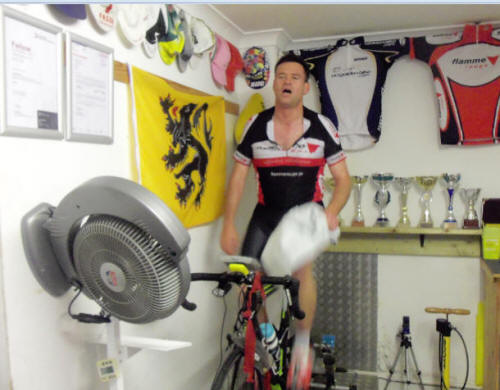
Lactate Testing ~ it's not pleaseant ask Paul Le Bihan...
Frogs Legs?
Finally (brace yourself for a
stunner), when you're
sprinting, climbing, hanging on in a crit, or doing a Ramp Test (as
above) and your legs are
screaming with "the
burn", that's not caused by lactic acid, lactate acid or any type
of acid whatsoever. Remove all thoughts of acid from your mind.
 The acid theory held sway from an early "frog's-legs" experiment before the
First World War. Voltage was applied to
dissected frog's legs, and ph measurements were taken until the muscle
fatigued. The ph at the end of the experiment was much lower than
the start, showing presumed "lactic acidosis".
The acid theory held sway from an early "frog's-legs" experiment before the
First World War. Voltage was applied to
dissected frog's legs, and ph measurements were taken until the muscle
fatigued. The ph at the end of the experiment was much lower than
the start, showing presumed "lactic acidosis".
The conclusion was that acid was the cause of fatigue, and the acid was present due to the lack of oxygen to transport it away. The lack of oxygen was probably due to the lack of a body (and lungs) being attached to the legs! It took the Lactate Shuttle work of George Brooks and his discoveries (see end of this article), from the 1970's up until today, to change the world's understanding of lactate physiology.
Exercise science research and results are now peer reviewed much more stringently than they once were. Facts now hold sway over opinion but still the lactate myth hung on and to some extent hangs on, right up to the present day. Doesn't make it right though!
And very finally, there's the Lactate Paradox. It's been found that lactate accumulations in Everest climbers (high altitude, low oxygen content), decreases as altitude increases. We also know that lactate is produced when at rest, with more than abundant oxygen present. So it can be assumed, that lactate production is not solely oxygen dependent, present or otherwise.
So, lactate isn't acid, it doesn't make your legs burn, it isn't oxygen dependent and it doesn't cause debilitating muscle fatigue. Now we've cleared all that up, and confused the hell out of you, we can move on...
Where's
Lactate Come From?
It is now probably safe to conclude that lactate production results from
energy produced through the glycotic energy system. Which means
the energy produced through the burning of glucose, which as you all
know comes from the carbohydrates we eat.
You will all be familiar with the terms, aerobic and anaerobic. Aerobic means "with oxygen", anaerobic means "without oxygen". So your recovery rides should be aerobic and your sprint intervals will be anaerobic.
Having said that, it's not 100% of one or the other. Everything we do uses a portion of aerobic/anaerobic energy to make up the whole. By definition, your aerobic energy pathways are being used on a sliding scale right up to your VO2max.
When we are predominantly anaerobic our effort is consuming more oxygen than our body can supply. Knowledge gained from your own riding should lead you to the conclusion that this means we must be going fast, or hard, thus burning lots of glycogen as fuel.
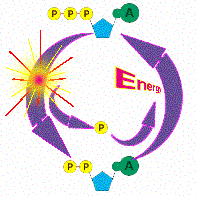
Glycolysis is the process that feeds ATP to the muscles as fuel. Pyruvate (like car exhaust gas) is the end product of glycolysis.
At submaximal levels of intensity (with oxygen), pyruvate is immediately utilised for aerobic energy, as can be seen in the diagram above. This is fuel, and energy, for free.
How this happens is explained in the Anaerobic Capacity factsheet, it's fairly complicated but it just happens the way ice forming at night, melts back to water in the day, and freezes back to ice again at night. It just happens a lot quicker inside your body.
As intensity increases (at a differing point for all of us) the molecule (that was previously returned) misses getting "attached" and loses the chance to become a fuel source. It now becomes lactate.
So you can see that lactate comes from pyruvate. Depending on how well we process it determines at what point it turns from a friend in to a foe. At submaximal levels of exercise it's a fuel. At maximal levels it's a hindrance.
Your job as a performance cyclist is to increase the submaximal level at which this process transition takes place, thereby making yourself more efficient. The person with the highest wattage/speed/heart rate transition point (the red line) will probably be the rider you've been chasing for the last hour.
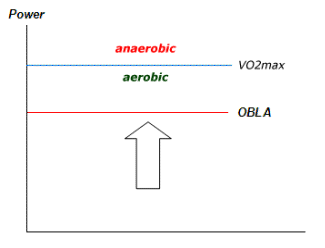
So how do you get to make this little molecule turn back in to glucose (fuel for free) and stop it becoming debilitating lactate?
Thresholds
Revisited!
Having previously said there is no such thing as an "anaerobic
threshold" I'm now going to have to use the term because it's a term
you've all heard and probably understand. But I'll expand on it a
little.
We all use the term "threshold." But for all of us it has a different meaning. Someone riding 10 mile time trials will ride at a different threshold to someone riding a 25 or 100 mile TT, or someone climbing a mythical mountain in a seven hour sportive. So we can see that the term "threshold" is relative to you, your current level of fitness, and the event you are riding.
 Using the common
understanding of the incorrect term "anaerobic threshold", it can be assumed that a 10 mile
TT rider will ride just above it; a 25 mile TT-er will be just on it;
and a 50 mile TT-er will be just under it.
Using the common
understanding of the incorrect term "anaerobic threshold", it can be assumed that a 10 mile
TT rider will ride just above it; a 25 mile TT-er will be just on it;
and a 50 mile TT-er will be just under it.
The "anaerobic threshold" is around the intensity where lactate production is equaled by lactate removal. Again, the red line in the chart above.
At around this point you could say lactate production and removal are "in balance". When they are, you have a nice stone tower. When they're not, you have a pile of bricks.
Although the terms are different from a physiological level, it's around this perception and "feeling" that we begin the onset of blood lactate accumulation (OBLA). The OBLA is the point where we start producing lactate quicker than we can remove it. It's more of a mouthful than anaerobic threshold but it is descriptively correct for the physiological process that's happening within our bodies.
If we go any harder we will begin to accumulate lactate. We can sustain just above this level for up to 30 minutes before it becomes detrimental to onward progress (hence the 10 mile TT reference above). See the Cori Cycle at the end of this factsheet for the reason why.
And to add even more confusion, we have Functional Threshold Power (FTP) to consider. This effort, by definition, lasts for an hour so it must occur at less power than OBLA.
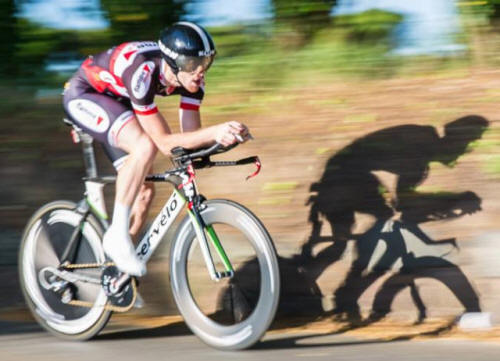
Rich Palmer ~ 25 mile TT at FTP
photo ~ Sue Armes
It's possible for most of us to ride a 10 mile TT at just above OBLA but I would suggest you wouldn't want to try to climb the Tourmalet at the same level of effort.
Because this level of effort (power/heart rate) represents the lactate balance, some people call it the lactate threshold, or lactic threshold. As explained above both these terms are technically wrong but they've all become interchangeable in the wide-ranging lexicon of cycling. They are physiologically different but to the masses, they mean the same thing.
Effectively, if you want to improve as an athlete, you need to find the level just before the lactate balance point. This is now referred to as your maximum lactate steady state (MLSS). Which is obviously the highest speed/power/heart rate at which you can ride where your body makes best use of the lactate you are producing. At this magical point, lactate works for you not against you.
Armed with this information, you can now train to improve your power output at MLSS and drive your self limiting OBLA red line closer to your genetically gifted VO2max blue line.
Lactate Testing
Tests to determine lactate accumulation are (providing you've spent a
couple of grand on equipment) relatively easy to undertake. You (the athlete) pedal, while I (the sadist) ramp up the pressure until
exhaustion and measure your blood lactate at pre-determined intervals as we go.
It used to be assumed that the threshold was when the blood measurement went above 4 millimol of lactate. But we are all different and 4 mmol for me could be a very different feeling to 4 mmol for you.
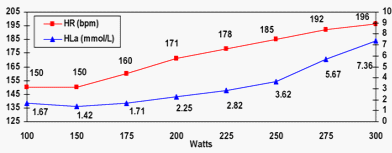
The current recognised way of defining an individual's lactate turning point is when two consecutive measurements increase by 1 mmol or more. It doesn't really matter what the number of the measurements are, as long as they slowly (and sustainably) rise.
A flat curve indicates that the body is utilizing and recycling lactate as fuel as fast as it's being produced. Once a "+1mmol ramp" appears on the graph it demonstrates that the balance point is being approached. When you get two +1 jumps in succession, it's safe to say the balance point's been reached and breached.
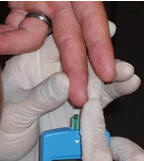 Although
we've now identified the OBLA, we keep going with the ramp.
Although
we've now identified the OBLA, we keep going with the ramp.
We know further effort will just bring about the end sooner than you'd like but we carry on until exhaustion as we get important VO2max information from the same test.
This doubles your value of the test and proves just how quickly the end does come when you press too hard.
For some this information, and the closeness to fatigue from a point of "relative comfort" is a real eye-opener. This feeling, perception and experience is often the point in their cycling career at which their understanding of training principles, and their subsequent racing results, moves to the next level. It can be a real epiphany.
What's the Point?
By measuring lactate
accumulation an athlete can establish their current point of exercise excellence.
The point at which they can just sit there and, potentially, cruise all
day. If
your MLSS point is at a higher wattage than mine, then guess who's going
to be giving, and getting, a kicking out on the road.
The resulting conclusion of all this drivel is that you should be looking to pinpoint the level of effort that is right at the edge of your maximum lactate steady state production/utilization. Once you've done that you can go about improving it.
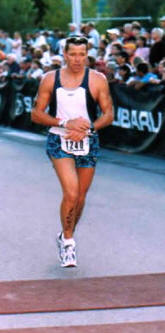 Working in Practice
Working in Practice
If you want a real live example
of how this works then we should look no further than the world of
IronMan athletes (like riding partner Richard Davy on the right) and
marathon runners.
I'm sure you've seen the scenes at the end of the London Marathon or an IronMan event when the skinny leaders come across the line utterly exhausted.
Well here's a surprise for you. Their lactate measurements at the end of the event are stupidly low. The good ones cruise at 1 mmol above their baseline for the majority of the event.
They ramp up to their maximum lactate steady state level as the race moves on. And for the swim and run they haven't even got a power meter!
These top athletes run right on the edge of their MLSS, remaining aerobic, using predominantly fat for fuel, saving carbs and recycling their pyruvate to get their race winning fuel for free. When did you last see a marathon runner throwing a load of power bars and gels down their throat in a race?
We all try to race like a 100 metre sprinter. We should be thinking with an ultra-endurance athlete's mindset if we want to be more successful in our quest for greatness. At least for 99.9% of our chosen event.
What
Now?
Obviously if you wan to improve your performances through developing
your lactate metabolism, a Lactate Performance Evaluation is required.
This test will determine your individual Onset of Blood Lactate
Accumulation wattage and heart rate.

And that opens up a whole new world of training opportunities that we'll cover next time.
The
Message
Lactate is a by-product, not a waste product, of exercising. It should be seen as your friend not your enemy.
Although, as with all
things in life, everything in moderation.
Lactate is an output of anaerobic exercise and an input for aerobic exercise. When you ride within the grey area that's the boundary of both, you're potentially in to a free ride. The person that maximises their wattage at this boundary point is on to a winner. Quite literally.
If you can produce the same or more power with less resultant lactate, you're becoming much more efficient as a cyclist. Cycling is an endurance sport and efficiency is key to conserving your valuable energy resources. No use being the best sprinter in the race if you're not there at the end to use it.
At the point just before the Onset of Blood Lactate Accumulation is the Maximum Lactate Steady State level. This is the point you want to move up your power and speed, and down your heart rate, scale. Measure your OBLA, train to improve your MLSS, go off and win some time trials, stay away in a break, or climb like a god. How hard can it be?
Lactate Testing & Training Part II
If you want to get really heavy, here's some additional info that adds
depth/confusion to that already created above.
The reason we "carbo-load" before a big event is so we can saturate our liver and muscles with energy giving glycogen to help us through our event.
The multi-functional liver (through the Cori Cycle (see below)) is capable of supplying glycogen, via the bloodstream, to wherever it's needed within the body. Individual muscles, however, can only use the glycogen that is embedded within that particular muscle. Once it's in the muscle it can't leave to go anywhere else.
So when you're climbing, your glycogen-full shoulder and arm muscles are incapable of sending any spare fuel to your energy depleted legs. You're dying on your ass and your arms are full of energy giving and race winning glycogen that your legs can't utilise. How rubbish is that?
Lactate is a different animal and operates in a different way. Remember that lactate can be used as fuel. So this bit is quite important.
There are special transporter proteins who's job it is to take lactate from the blood and deliver it to muscles around the body. This has the dual function of lowering localised blood lactate concentration (by dispersing it around the body) and bringing much needed fuel to muscles that require it.
This submaximal effort "supplementary muscle fuelling" happens far quicker than you eating an energy bar and waiting for the digestion process to kick in and deliver glycogen from the liver. This is the reason we need to make lactate our friend and to embrace it like it is the wind at our back!
Finding the wattage/heart rate where this shuttle is working at its optimum efficiency is important to you as an athlete. It could be the difference between a top ten and a podium place in your target event.
The Cori Cycle
The Cori Cycle is a training partner of the Lactate Shuttle. It
has a different function but it's complimentary to your understanding of
lactate and going faster.
The Cori Cycle describes the metabolic pathway that uses our blood to transport the energy by-product lactate to the processing marvel that is our liver.
Once in the liver, the lactate is converted to glycogen, then to glucose through a process called gluconeogenesis. The blood is then used to transport the glucose back to the muscles. Once in the muscle it converts back to glycogen for fuel, is used and if you're still going flat out is converted back to lactate. Simple!
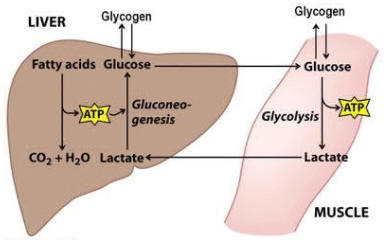
This process cannot be sustained indefinitely. You don't get something for nothing in this world; there's a price to pay for everything.
The liver cleverly attaches two stored ATP molecules to the incoming lactate to change it to outgoing glycogen. But it costs the liver six ATP molecules to be able to do this. So the liver suffers a four molecule deficit for each "upgrade" it carries out.
Sooner or later (around 30 minutes depending on pre-event hydration and fuelling levels) the energy giving stocks will be exhausted. When that happens, you bonk, you stop.
The only way to get back in to ATP credit is to back off the intensity until you reach a level of positive balance. From there, you have to surf the wave that is lactate balance if you want to get to the end of the day before the time cut-off.
Finally, Why do my legs
hurt?
The burning in your legs is
caused by muscle polar and de-polarisation! It's to do with
ionisation not acid. We'll cover that another day.








